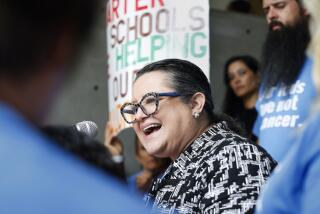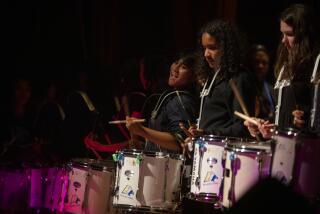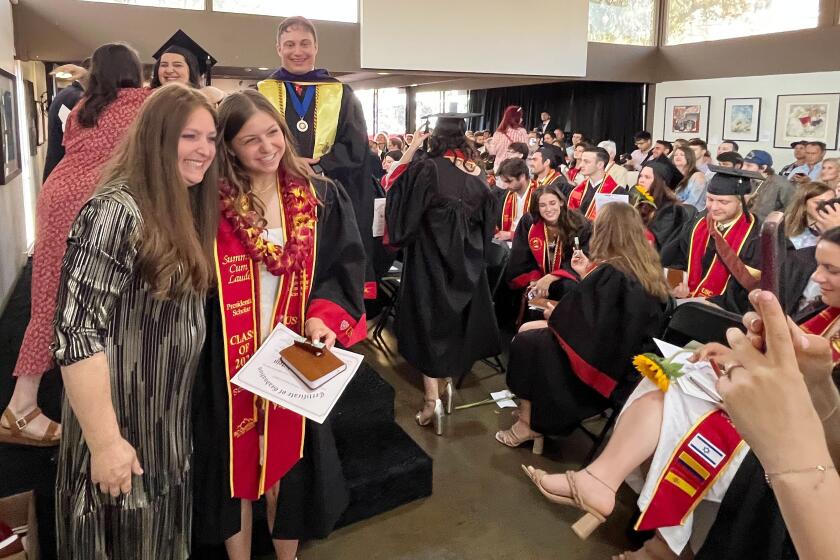Hundreds Wait for Bilingual Education
Hundreds of students whose parents have petitioned for bilingual education in the Los Angeles school system are in limbo while principals try to arrange bilingual classes.
The problem is that dozens of schools have received just a handful of requests for bilingual education in the wake of Proposition 227--not enough to form even one class.
Data released this week by the Los Angeles Unified School District show that 11,809 requests have been filed for exemptions from English immersion. The district says it has no evidence that any have been turned down.
But a Times analysis of the data and interviews with principals reveals the district is unable to immediately accommodate everybody.
At least 68 schools received 1 to 20 waiver requests. Under the law, schools are required to offer bilingual classes when at least 20 students in a given grade are granted so-called waivers from English-intensive classes.
“If I don’t get 20 waiver requests, the best I can offer is Model B,” said Normandie Avenue Elementary Principal Barbara Wright, where 15 parents have filed waiver applications.
Wright was referring to one type of class the district has created to comply with the anti-bilingual education proposition. Model B students are taught “primarily” in English but receive “support” in their native languages from bilingual teachers.
And what to do when just one student wants bilingual education? At least 10 schools faced that dilemma. In one case, an elementary school student has been placed in an English-immersion class until officials can determine if another school can take the child.
But another campus was more accommodating.
At Norwood Street Elementary, a third-grade girl was the child whose parents sought a waiver. She is being taught mostly in Spanish in a class shared by 16 English immersion students.
“The district says we must comply with a parent’s request--we’ve done that,” said Norma Diaz, Norwood’s bilingual education coordinator. “These parents felt their child would better understand and be more successful in her primary language than she would have been in English language instruction. We respect that.”
The data also showed that many schools in the Los Angeles area that once had large bilingual programs are in for significant change in the wake of the proposition.
Last school year, there were at least 286 campuses in the district with 100 or more students in bilingual programs. This year, the preliminary data show, there were just 43 schools that received 100 or more requests for bilingual education.
In more than half of the campuses that previously had 100 students in bilingual education, not one petition for bilingual education had been received as of mid-October.
One such school was Canoga Park Elementary. In 1997-98 there were 555 students in that school in bilingual classes. This year the school has received no petitions for bilingual education.
Forrest Ross, a district official who oversees implementation of Proposition 227, was principal at the school until recently. When asked why there appears to be little momentum for bilingual education at his former school, Ross suggested that many parents are still weighing their options.
Indeed, district Supt. Ruben Zacarias said he did not view the initial data as a repudiation of bilingual education. Instead, he said parents have grown tired of the controversy and are simply searching for a middle road.
“I can’t speak for why parents chose one option versus another,” Zacarias said. “But my intent in the process was to give parents clear options.”
The most popular option so far has been Model B.
“I believe that many parents believe they are getting the best of both worlds in Model B,” said Liliam Castillo, deputy superintendent of instruction and curriculum. “These are parents who believe this is a new way of teaching and want to try it out, give it a shot.”
In February, the district will begin shifting curriculum and resources, adjusting budgets and moving staff to where students will ultimately settle. Officials have already already begun talks with textbook publishers about swapping or repurchasing about $5-million worth of Spanish-language materials that became superfluous in the aftermath of Proposition 227.
Finally, the data released this week showed the enduring popularity of a specialized form of bilingual education known as “dual immersion,” in which English speakers typically are taught Spanish and Spanish speakers learn English.
In addition to the other waiver requests, there were 784 petitions for students to continue in dual immersion classes in at least 11 schools.
More to Read
Start your day right
Sign up for Essential California for news, features and recommendations from the L.A. Times and beyond in your inbox six days a week.
You may occasionally receive promotional content from the Los Angeles Times.







